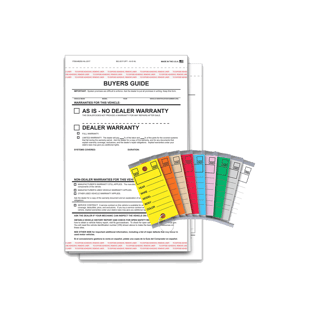
More Government Stimulus...What's in it for Your Dealership?
The extension of the PPP loan program was a welcome surprise at the end of 2020. We all breathed a huge collective sigh of relief when we read that the expenses paid for with forgiven PPP funds would be deductible. Now if we can just get all states to get on board! The new legislation also included a PPP2 loan program, which is exciting for many business owners that benefited from PPP1. PPP2; however, comes with a caution, discussed in more detail below, that may eliminate many dealers from participating in this second round of government aid the SBA opened to everyone on January 19, 2021.
PARTNER SPOTLIGHT
Dealer Management System, Computer Technology, Media/Advertising, Automotive Auction, F & I/Aftermarket Products, Automotive Technology Training & Compliance
 A NHADA Gold PARTNER
A NHADA Gold PARTNERComputer Technology, Automotive Shop Equipment, Environmental Services
 A NHADA Platinum PARTNER
A NHADA Platinum PARTNERF & I/Aftermarket Products, Automotive Technology Training & Compliance, Environmental Services
.png?width=150&name=corp_logo_horz_on_light_with_trademark_symbol_1200w%20(002).png) A NHADA Diamond PARTNER
A NHADA Diamond PARTNERF & I/Aftermarket Products, Financial Services, Automotive Technology Training & Compliance
 A NHADA Diamond PARTNER
A NHADA Diamond PARTNERIn order to qualify for PPP2, businesses must have experienced a 25% decline in sales in any quarter of 2020 compared with the same quarter in 2019 and must have less than 300 employees. This is a slight change from PPP1 where there wasn’t a requirement that sales had slipped and the headcount figure was 500 not 300. Regardless, all of the other franchise indicator code exceptions and other requirements carryover from the original PPP program under the CARES Act.
Similar to the first round of PPP loans, there is a requirement that a business owner certify that the loan is needed due to economic uncertainties that threaten the businesses continuation and ability to keep people employed. This certification may not be as easy to make as it was during the first round of PPP funding. We believe this requirement will be scrutinized more carefully this time around. If your business prospered during 2020 and hasn’t experienced significant losses like we expected would happen during the initial phases of the pandemic, then we recommend proceeding cautiously with a PPP2 request, even if you can demonstrate your sales were down in a given quarter.
One overlooked, and significant change in the legislation, is regarding the Employee Retention Credit. When this credit was first introduced, we all diligently read the legislation and at the very end there was a statement that essentially said – “if you’ve received a PPP loan, then you don’t qualify for an ERC.” Our thought then was…”Why didn’t you say that in the first place?!!!” Well now those of you that did receive a PPP loan can also potentially qualify for the ERC. Unfortunately, it’s MUCH more complicated than that, but the credit can be significant, so it’s worth your time figuring it out. The credit is up to $5,000 per employee for the year 2020 and has been expanded to the 1st two quarters of 2021 and increased to a maximum credit of $7,000 per employee per quarter through the quarter ending June 30, 2021. That means you could receive up to $14,000 per employee for 2021. The way to claim the credit is through the payroll tax system. In other words, you’ll reduce the amount of your payroll tax deposit by the amount of the credit you are claiming when remitting payroll taxes.A few additional important pieces of information are as follows.
PPP Quick Tips:
- Those employers that had more than 100 full-time employees are only able to get a credit in 2020 for those employees that they paid NOT to work. If you had less than 100 full-time employees, and you qualify for the credit, you get the credit for up to 50% of any wages paid to the employees.
- Similar to when you determined whether or not you qualified for a PPP loan, when determining how many employees you have for purposes of the 100 full-time employee qualification, you count employees, not FTEs. In other words, if an employee worked more than 30 hours per week, they count as 1 employee.
- If you claim the credit then the amount of the credit received is not included in your deductible wages on your return.
- As mentioned above, this credit is claimed on your PAYROLL TAX returns, not your income tax return.
- You get the credit in 2020 for as long as you had a partial or full government shutdown OR for any quarter beginning with the first calendar quarter in 2020 where your gross receipts declined 50% compared to the same quarter in 2019 until the end of the quarter where gross receipts compared to the same quarter in 2019 declined less than 20%.
- The franchise indicator code doesn’t apply to this credit. Therefore, If you have multiple dealerships, a body shop, insurance company or other businesses then you follow the aggregation rules used by the IRS for other consolidating purposes. Those rules require that you combine businesses if any individual directly or indirectly owns more than 50% of the voting stock or common management of each company in determining how many employees you have.
- For 2021, the credit is based on a decrease in gross receipts in calendar quarter 1 or 2 compared to the same quarter in 2019 of 20% instead of the 50% requirement for 2020. The number of full-time employees also increases to 500 for determining what wages paid qualify.
- Note that you can’t double dip, so payroll used for PPP forgiveness cannot also be used for the ERC.
One of the reasons the ERC is such a big deal is because if you qualify, there is no need to certify that you need the credit. That means many more employers are likely to benefit from this program.


















.png?width=150&name=Ally_Final%20Logos%20and%20Pairings_11.14.2018-01%20(2).png)


-2.png?width=150&name=Wipfli%20Logo%20Blue%20RGB%20(1)-2.png)


.jpg?width=150&name=NHADA_Partner_FTR_Img_NHADA_Insurance%20(1).jpg)


.jpg?width=150&name=NHADA_Partner_FTR_Img_JMA(1).jpg)





